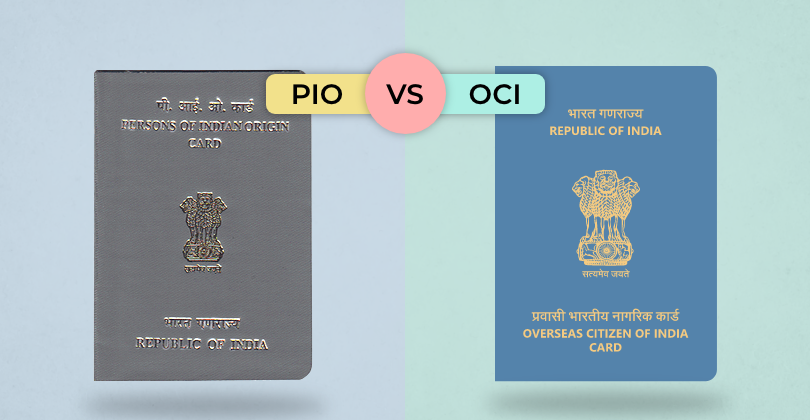Are you of Indian origin and living abroad? You've probably come across terms like PIO and OCI. These cards offer different benefits, but it can
In the ever-evolving landscape of taxation, the concept of Integrated Goods and Services Tax (IGST) has great significance in commerce, trade, and business. As a crucial component of India's Goods and Services Tax (GST) framework, IGST plays a pivotal role in facilitating seamless interstate transactions while ensuring fair revenue distribution among states.
In this comprehensive exploration, we will delve into the nuances of IGST, outline the differences between integrated tax and IGST, and decipher the underlying purpose behind the implementation of IGST.
What is IGST?
Integrated Goods and Services Tax (IGST) is an indirect tax levied on the supply of goods and services that take place across state lines within India. It is one of the four tax components introduced as part of the historic GST regime that replaced the previous complex tax structure.
The other three components are Central Goods and Services Tax (CGST), State Goods and Services Tax (SGST), and Union Territory Goods and Services Tax (UTGST). IGST operates on the principle of a unified tax structure for the entire nation, unifying the tax laws and procedures for inter-state transactions.
It brings about uniformity in the tax treatment of interstate supplies of goods and services, thereby eliminating the need for multiple taxes, complexities, and entry barriers that previously plagued the Indian taxation system.
The revenue generated from IGST is subsequently divided between the central and state governments based on a defined formula.
What is the Difference Between Integrated Tax and IGST?
While the terms "integrated tax" and "IGST" are often used interchangeably, they have distinct connotations within the GST framework. Integrated tax refers to the combination of both CGST and SGST/UTGST on inter-state supplies of goods and services.
In simpler terms, integrated tax is the sum of taxes levied by both the central and state governments on cross-border transactions.
On the other hand, IGST, or Integrated Goods and Services Tax, is a unique tax in itself. It is the single tax that encompasses the taxation of inter-state supplies. Unlike the combination of central and state taxes that form integrated taxes, IGST is administered and collected by the central government.
This centralised collection and administration mechanism streamlines the process, reducing complexities and ensuring smoother inter-state trade.
To illustrate this difference with an example: consider a scenario where a manufacturer in Maharashtra supplies goods to a retailer in Karnataka. In this case, the manufacturer would charge IGST on the transaction, which is then remitted to the central government.
The central government subsequently distributes the revenue between Maharashtra and Karnataka based on a fixed formula defined by tax laws.
What is the Purpose of IGST?
The implementation of IGST serves multiple purposes, all aimed at simplifying and streamlining the taxation system, fostering economic growth, and ensuring equitable distribution of revenue among states.
-
Seamless Inter-State Trade
One of the primary objectives of IGST is to facilitate the hassle-free movement of goods and services across state boundaries. The elimination of multiple taxes and cumbersome documentation reduces logistical and administrative bottlenecks, making inter-state transactions more efficient and cost-effective.
-
Elimination of Tax Cascading
In the pre-GST era, the taxation structure often led to a cascading effect, where taxes were levied on top of taxes. This resulted in increased prices and reduced competitiveness. IGST ensures that only the final consumer bears the tax burden, as credits of taxes paid on previous stages are available for offset against the final liability.
-
Uniform Taxation
IGST contributes to the creation of a uniform tax regime across the nation. This simplification encourages compliance and reduces instances of tax evasion, as businesses find it easier to navigate standardised tax procedures.
-
Efficient Revenue Distribution
One of the crucial aspects of IGST is its revenue-sharing mechanism. The central government collects the IGST and then distributes it among the respective states. This ensures that states with higher consumption patterns receive their due share of revenue, irrespective of the origin of the supply.
-
Boosting Economic Growth
By facilitating smoother interstate trade, IGST contributes to a more competitive business environment. Reduced taxation complexities and improved efficiency lead to better utilisation of resources, fostering economic growth and development.
-
Encouraging Digital Transformation
The implementation of IGST has encouraged businesses to embrace digital platforms for tax compliance. The online GST portal allows for easy registration, filing of returns, and payment of taxes, aligning with the government's vision of a digital economy.
-
Transparent Taxation
IGST promotes transparency in the taxation process. Both businesses and consumers can verify the tax calculations and payments through the GST portal, reducing the scope for hidden charges and tax discrepancies.
📗 Related reading- Can You Get Tax Benefits on Personal Loans?
What are the Challenges and Future Outlook for IGST Implementation?
While the Integrated Goods and Services Tax (IGST) has brought significant advancements to India's tax landscape, its implementation has not been without challenges.
One of the key hurdles is the need for effective coordination between the central and state governments to ensure seamless revenue distribution. Disputes can arise regarding the classification of goods and services, leading to potential delays and confusion.
Furthermore, technological glitches on the GST portal sometimes hamper the processes for tax compliance, emphasising the need for continuous technological upgrades and user-friendly interfaces. The complex nature of certain transactions, especially those involving multiple states, necessitates robust mechanisms for dispute resolution and clarity in legal provisions.
Looking ahead, the future of IGST lies in refining its mechanisms to enhance efficiency and address these challenges. Strengthening intergovernmental cooperation, investing in technological infrastructure, and providing timely guidance to businesses are crucial steps.
With these efforts, IGST can continue to fulfil its purpose of fostering seamless inter-state trade, boosting economic growth, and contributing to India's vision of a simplified and transparent tax regime. As the nation evolves, so will IGST, playing a pivotal role in shaping India's economic landscape for years to come.
Conclusion
Integrated Goods and Services Tax (IGST) stands as a testament to India's commitment to simplifying and modernising its tax structure. By unifying the taxation of inter-state supplies under a single tax umbrella, IGST streamlines processes, reduces complexities, and encourages economic growth.
Through its equitable revenue-sharing mechanism, IGST ensures that the benefits of interstate trade are shared among the states, fostering cooperative federalism. As India continues its journey towards economic progress and ease of doing business, IGST remains a crucial cornerstone in the edifice of taxation reform.
AUTHOR
KreditBee As a market leader in the Fintech industry, we strive to bring you the best information to help you manage finances better. These blogs aim to make complicated monetary matters a whole lot simpler.







